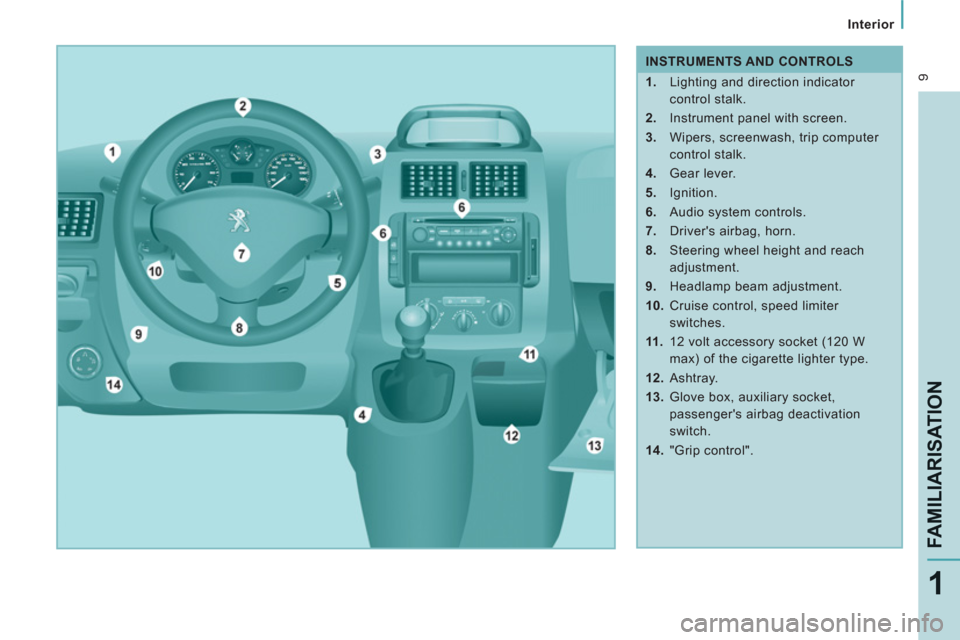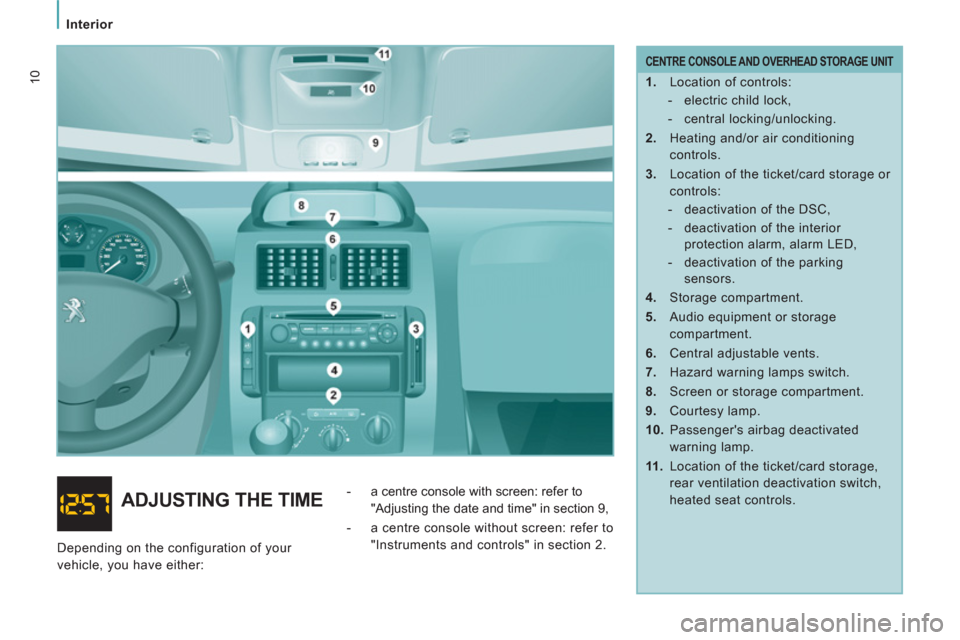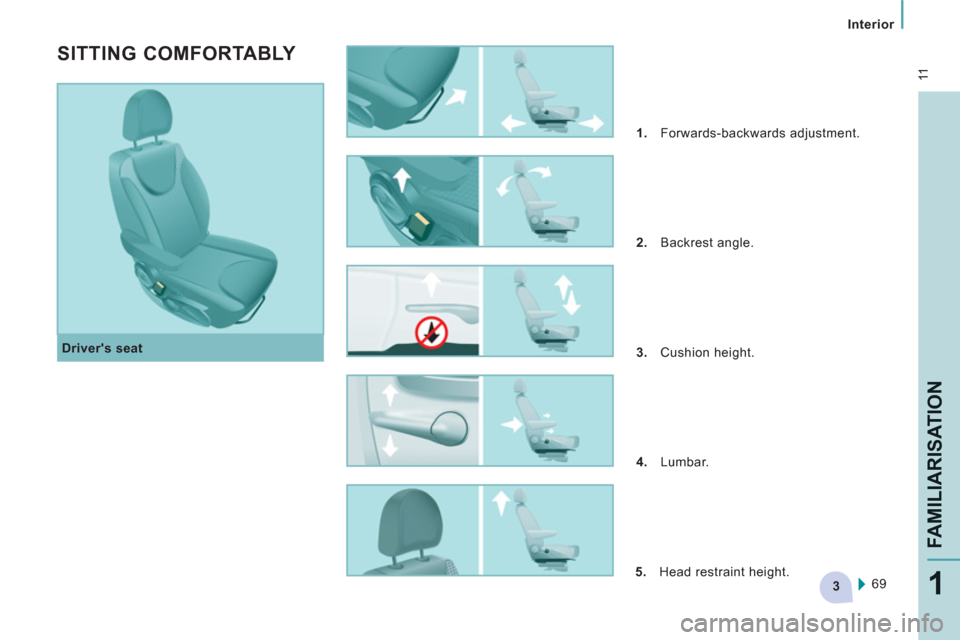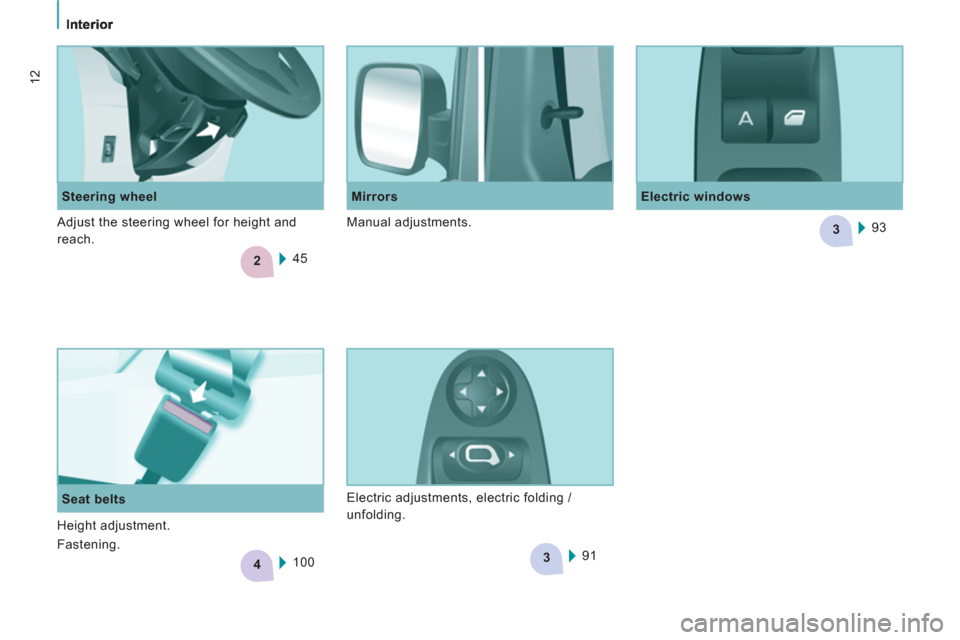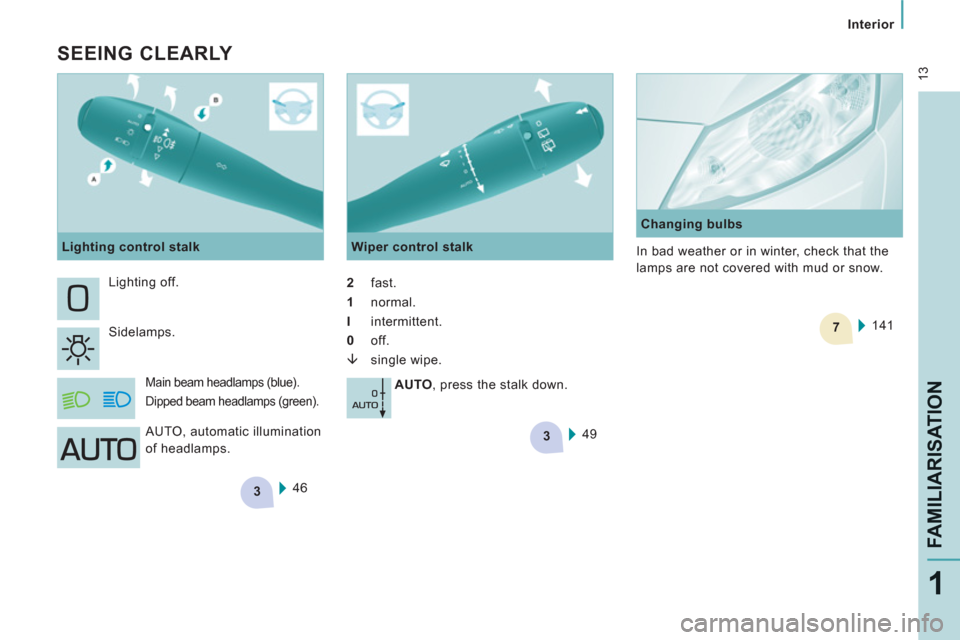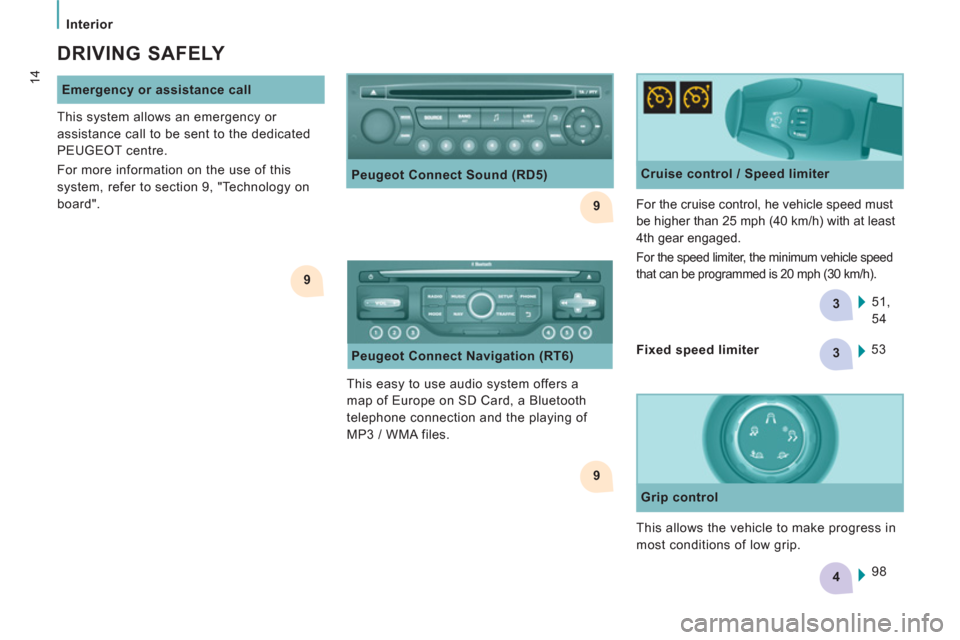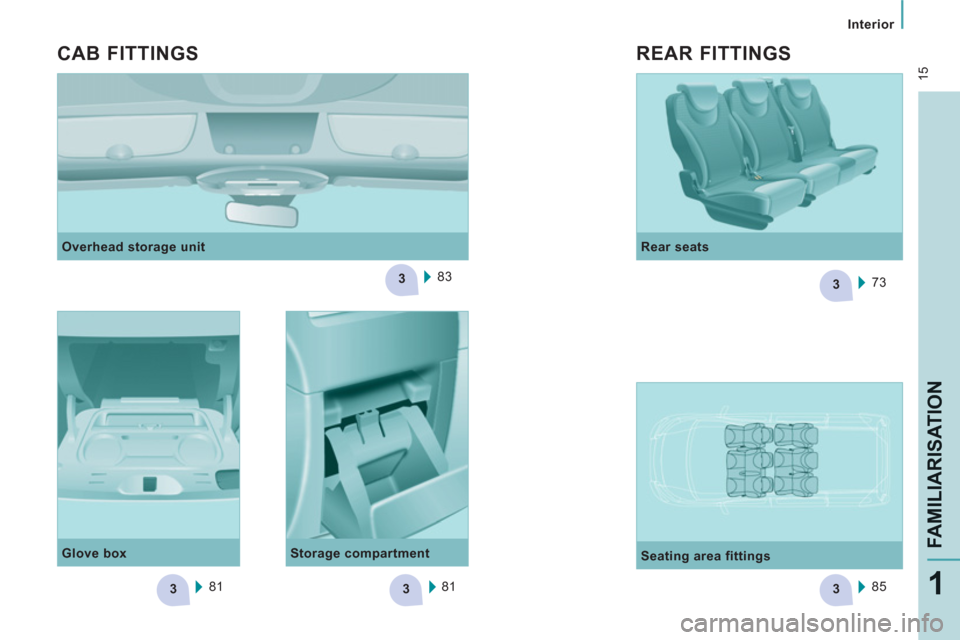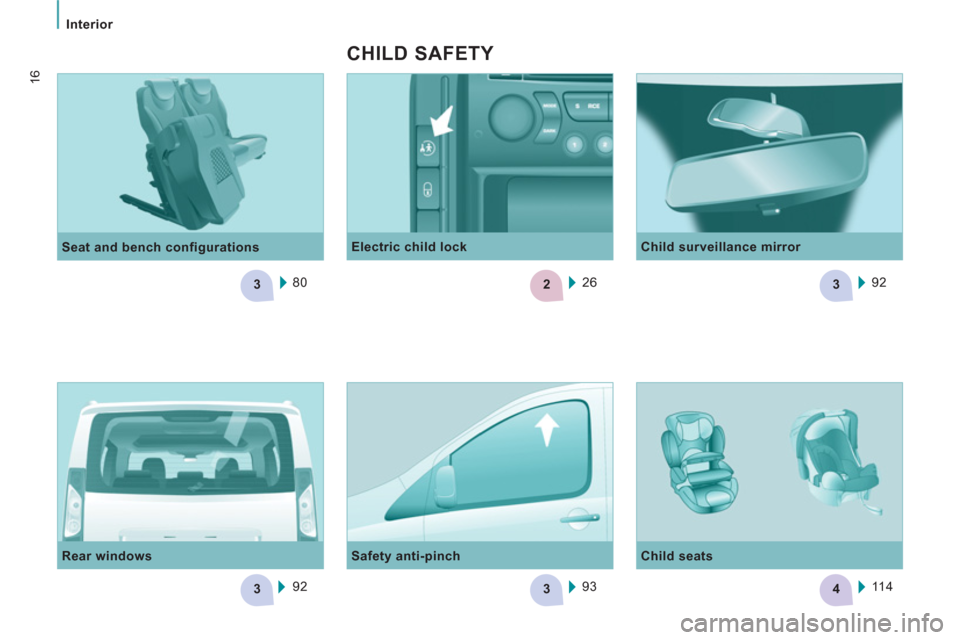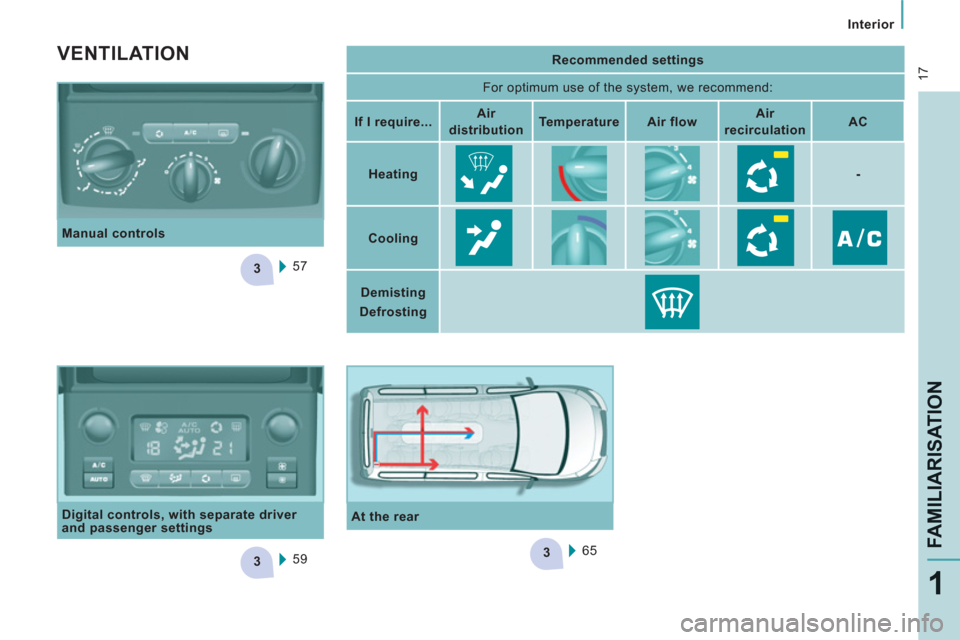Peugeot Expert Tepee 2013 User Guide
Expert Tepee 2013
Peugeot
Peugeot
https://www.carmanualsonline.info/img/29/15860/w960_15860-0.png
Peugeot Expert Tepee 2013 User Guide
Trending: navigation, compression ratio, audio, child seat, fuel type, checking oil, maintenance
Page 11 of 260
9
Interior
FAMILIARISATIO
N
1
INSTRUMENTS AND CONTROLS
1.
Lighting and direction indicator
control stalk.
2.
Instrument panel with screen.
3.
Wipers, screenwash, trip computer
control stalk.
4.
Gear lever.
5.
Ignition.
6.
Audio system controls.
7.
Driver's airbag, horn.
8.
Steering wheel height and reach
adjustment.
9.
Headlamp beam adjustment.
10.
Cruise control, speed limiter
switches.
11 .
12 volt accessory socket (120 W
max) of the cigarette lighter type.
12.
Ashtray.
13.
Glove box, auxiliary socket,
passenger's airbag deactivation
switch.
14.
"Grip control".
Page 12 of 260
Interior
10
CENTRE CONSOLE AND OVERHEAD STORAGE UNIT
1.
Location of controls:
- electric child lock,
- central locking/unlocking.
2.
Heating and/or air conditioning
controls.
3.
Location of the ticket/card storage or
controls:
- deactivation of the DSC,
- deactivation of the interior
protection alarm, alarm LED,
- deactivation of the parking
sensors.
4.
Storage compartment.
5.
Audio equipment or storage
compartment.
6.
Central adjustable vents.
7.
Hazard warning lamps switch.
8.
Screen or storage compartment.
9.
Courtesy lamp.
10.
Passenger's airbag deactivated
warning lamp.
11 .
Location of the ticket/card storage,
rear ventilation deactivation switch,
heated seat controls.
ADJUSTING THE TIME
- a centre console with screen: refer to
"Adjusting the date and time" in section 9,
- a centre console without screen: refer to
"Instruments and controls" in section 2.
Depending on the configuration of your
vehicle, you have either:
Page 13 of 260
3
11
Interior
FAMILIARISATIO
N
1
Driver's seat
SITTING COMFORTABLY
1.
Forwards-backwards adjustment.
2.
Backrest angle.
3.
Cushion height.
4.
Lumbar.
5.
Head restraint height.
69
Page 14 of 260
2
4
3
3
12
Steering wheel
Electric windows
Mirrors
45
Seat belts
100 93
91 Adjust the steering wheel for height and
reach. Manual adjustments.
Electric adjustments, electric folding /
unfolding.
Height adjustment.
Fastening.
Page 15 of 260
3
3
7
13
Interior
FAMILIARISATIO
N
1
SEEING CLEARLY
46 Lighting off.
Sidelamps.
Main beam headlamps (blue).
Dipped beam headlamps (green).
Wiper control stalk
2
fast.
1
normal.
I
intermittent.
0
off.
�È
single wipe.
AUTO
, press the stalk down.
AUTO, automatic illumination
of headlamps.
Lighting control stalk
49
Changing bulbs
141
In bad weather or in winter, check that the
lamps are not covered with mud or snow.
Page 16 of 260
9
9
3
4
9
3
Interior
14
Emergency or assistance call
DRIVING SAFELY
Cruise control / Speed limiter
51,
54 For the cruise control, he vehicle speed must
be higher than 25 mph (40 km/h) with at least
4th gear engaged.
For the speed limiter, the minimum vehicle speed
that can be programmed is 20 mph (30 km/h).
This system allows an emergency or
assistance call to be sent to the dedicated
PEUGEOT centre.
For more information on the use of this
system, refer to section 9, "Technology on
board".
Peugeot Connect Sound (RD5)
This easy to use audio system offers a
map of Europe on SD Card, a Bluetooth
telephone connection and the playing of
MP3 / WMA files.
Peugeot Connect Navigation (RT6)
Fixed speed limiter 53
Grip control
98
This allows the vehicle to make progress in
most conditions of low grip.
Page 17 of 260
33
3
3
3
15
Interior
FAMILIARISATIO
N
1
Overhead storage unit
83
CAB FITTINGS
Glove box
81 81
Storage compartment
Rear seats
73
Seating area fittings
85
REAR FITTINGS
Page 18 of 260
3
33
23
4
Interior
16
80
Seat and bench configurations
92
Rear windows
Safety anti-pinch
93
Electric child lock
26
CHILD SAFETY
Child surveillance mirror
92
Child seats
11 4
Page 19 of 260
3
33
17
Interior
FAMILIARISATIO
N
1
Recommended settings
For optimum use of the system, we recommend:
If I require...
Air
distribution
Temperature
Air flow
Air
recirculation
AC
Heating
-
Cooling
Demisting
Defrosting
Manual controls
57
Digital controls, with separate driver
and passenger settings
59
At the rear
65
VENTILATION
Page 20 of 260
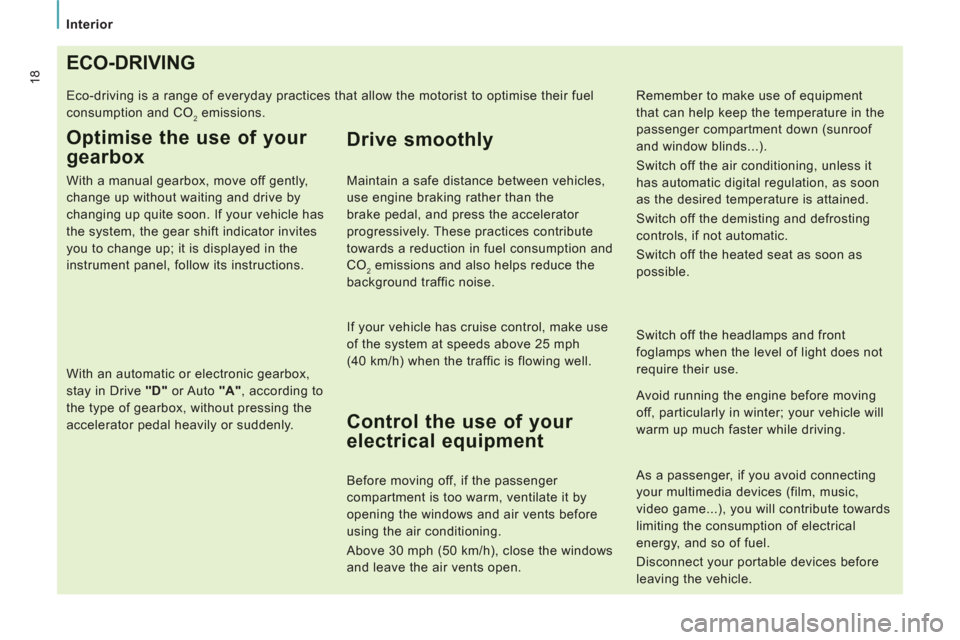
Interior
18ECO-DRIVING
Eco-driving is a range of everyday practices that allow the motorist to optimise their fuel
consumption and CO
2 emissions.
Optimise the use of your
gearbox
With a manual gearbox, move off gently,
change up without waiting and drive by
changing up quite soon. If your vehicle has
the system, the gear shift indicator invites
you to change up; it is displayed in the
instrument panel, follow its instructions.
With an automatic or electronic gearbox,
stay in Drive "D"
or Auto "A"
, according to
the type of gearbox, without pressing the
accelerator pedal heavily or suddenly.
Control the use of your
electrical equipment
Before moving off, if the passenger
compartment is too warm, ventilate it by
opening the windows and air vents before
using the air conditioning.
Above 30 mph (50 km/h), close the windows
and leave the air vents open.
Switch off the headlamps and front
foglamps when the level of light does not
require their use.
Avoid running the engine before moving
off, particularly in winter; your vehicle will
warm up much faster while driving.
Drive smoothly
Maintain a safe distance between vehicles,
use engine braking rather than the
brake pedal, and press the accelerator
progressively. These practices contribute
towards a reduction in fuel consumption and
CO
2 emissions and also helps reduce the
background traffic noise.
If your vehicle has cruise control, make use
of the system at speeds above 25 mph
(40 km/h) when the traffic is flowing well.
As a passenger, if you avoid connecting
your multimedia devices (film, music,
video game...), you will contribute towards
limiting the consumption of electrical
energy, and so of fuel.
Disconnect your portable devices before
leaving the vehicle.
Remember to make use of equipment
that can help keep the temperature in the
passenger compartment down (sunroof
and window blinds...).
Switch off the air conditioning, unless it
has automatic digital regulation, as soon
as the desired temperature is attained.
Switch off the demisting and defrosting
controls, if not automatic.
Switch off the heated seat as soon as
possible.
Trending: roof rack, coolant reservoir, engine oil, child seat, parking sensors, air conditioning, interior lights
